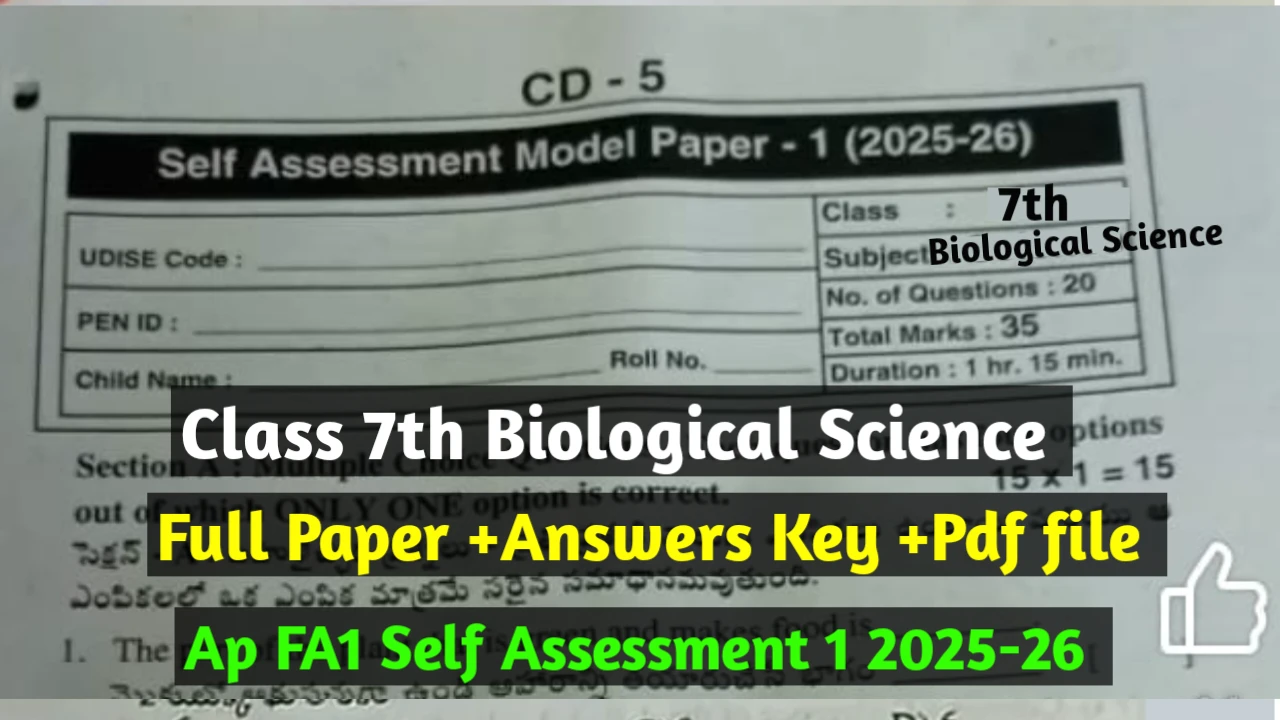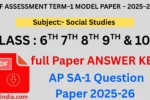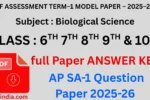AP FA1 7th Biological Science Self-Assessment – I 2025-26 Real Exam Question Paper answer pdf
Table of Contents
AP FA-1 – 2025-26
Class: VII – Biological Science / జీవవిజ్ఞాన శాస్త్రం
Self-Assessment – I / స్వీయ-మూల్యాంకనం – I
Time: 1 Hour / సమయం: 1 గంట
Max. Marks: 35 / గరిష్ట మార్కులు: 35
Section – A: Multiple Choice Questions / బహుళ ఎంపిక ప్రశ్నలు
(15 × 1 = 15 Marks)
- Plants prepare their own food by the process of:
మొక్కలు తమ ఆహారాన్ని తయారు చేసే ప్రక్రియ ఏది?
a) Respiration / శ్వాసక్రియ
b) Transpiration / ఆవిరీభవనం
c) Germination / మొలకెత్తడం
d) Photosynthesis / ప్రకాశ సంయోజన (Answer) - The raw materials for photosynthesis are:
ప్రకాశ సంయోజనకు అవసరమైన ముడి పదార్థాలు ఏవి?
a) CO₂ and O₂
b) CO₂ and H₂O / కార్బన్ డయాక్సైడ్ మరియు నీరు (Answer)
c) O₂ and H₂O
d) Glucose and O₂ - Which pigment captures sunlight in leaves?
ఆకులలో సూర్యకాంతిని గ్రహించే వర్ణకం ఏది?
a) Chlorophyll / క్లోరోఫిల్ (Answer)
b) Hemoglobin / హీమోగ్లోబిన్
c) Xanthophyll / జాంతోఫిల్
d) Carotene / క్యారోటీన్ - Photosynthesis occurs in which cell organelle?
ప్రకాశ సంయోజన ఏ కణాంగంలో జరుగుతుంది?
a) Mitochondria / మైటోకాండ్రియా
b) Chloroplast / క్లోరోప్లాస్ట్ (Answer)
c) Nucleus / కణకేంద్రం
d) Ribosome / రైబోసోమ్ - Which gas is released during photosynthesis?
ప్రకాశ సంయోజనలో విడుదలయ్యే వాయువు ఏది?
a) CO₂ / కార్బన్ డయాక్సైడ్
b) Oxygen / ఆమ్లజని (Answer)
c) Nitrogen / నైట్రోజన్
d) Hydrogen / హైడ్రోజన్ - Which part of the leaf has tiny pores for gaseous exchange?
ఆకులో గ్యాసుల మార్పిడి కోసం చిన్న రంధ్రాలు ఎక్కడ ఉంటాయి?
a) Stomata / రంధ్రాలు (Answer)
b) Cuticle / క్యూటికిల్
c) Midrib / మధ్యనాడి
d) Veins / నాళాలు - Which process in plants removes excess water?
మొక్కలలో అదనపు నీటిని తొలగించే ప్రక్రియ ఏది?
a) Photosynthesis / ప్రకాశ సంయోజన
b) Transpiration / ఆవిరీభవనం (Answer)
c) Respiration / శ్వాసక్రియ
d) Absorption / ఆవిర్భవనం - Plants that obtain food from other plants are called:
ఇతర మొక్కల నుండి ఆహారం పొందే మొక్కలను ఏమంటారు?
a) Autotrophs / స్వయంపోషకాలు
b) Parasites / పరాన్నజీవులు (Answer)
c) Saprophytes / శవాహారులు
d) Insectivorous / పురుగుతినే మొక్కలు - Which plant is an example of a parasite?
పరాన్నజీవి మొక్కకు ఉదాహరణ ఏది?
a) Cactus / కాక్టస్
b) Sunflower / సూర్యకాంతి
c) Cuscuta (Amarbel) / కస్కూటా (అమర్బెల్) (Answer)
d) Mango / మామిడి - The chemical equation for photosynthesis is:
ప్రకాశ సంయోజన రసాయన సమీకరణం ఏది?
a) C₆H₁₂O₆ + O₂ → CO₂ + H₂O
b) 6CO₂ + 6H₂O → C₆H₁₂O₆ + 6O₂ (Answer)
c) CO₂ + O₂ → H₂O
d) CO₂ → O₂ - Which plant traps insects for nitrogen?
నైట్రోజన్ కోసం పురుగులను పట్టుకునే మొక్క ఏది?
a) Money plant / మనీ ప్లాంట్
b) Pitcher plant / పిచ్చర్ ప్లాంట్ (Answer)
c) Cuscuta / కస్కూటా
d) Neem / వేప - In which part of the plant does photosynthesis mainly occur?
మొక్కలో ప్రకాశ సంయోజన ఎక్కువగా ఎక్కడ జరుగుతుంది?
a) Roots / వేరు
b) Leaves / ఆకులు (Answer)
c) Stem / తాడు
d) Flowers / పువ్వులు - Plants that grow without chlorophyll are:
క్లోరోఫిల్ లేకుండా పెరిగే మొక్కలు ఏవి?
a) Autotrophs / స్వయంపోషకాలు
b) Heterotrophs / పరపోషకాలు (Answer)
c) Hydrophytes / నీటిమొక్కలు
d) Xerophytes / ఎడారిమొక్కలు - Which part of the leaf contains chlorophyll?
ఆకులో క్లోరోఫిల్ ఏ భాగంలో ఉంటుంది?
a) Veins / నాళాలు
b) Cuticle / క్యూటికిల్
c) Mesophyll cells / మెసోఫిల్ కణాలు (Answer)
d) Petiole / కాండం - Plants take in carbon dioxide through:
మొక్కలు కార్బన్ డయాక్సైడ్ను ఎలా గ్రహిస్తాయి?
a) Veins / నాళాలు
b) Roots / వేరు
c) Stomata / రంధ్రాలు (Answer)
d) Flowers / పువ్వులు
read also- AP FA1 Question Paper (2025–26)
Section – B: Very Short Answer Questions / చాలా చిన్న సమాధాన ప్రశ్నలు
(2 × 2 = 4 Marks)
- Define photosynthesis. / ప్రకాశ సంయోజన నిర్వచించండి.
- English: Process by which green plants prepare food from CO₂ and water using sunlight in the presence of chlorophyll.
- Telugu: పచ్చ మొక్కలు క్లోరోఫిల్ సమక్షంలో సూర్యకాంతి సహాయంతో CO₂, నీటిని ఉపయోగించి ఆహారం తయారు చేసే ప్రక్రియ.
- Write two examples of insectivorous plants. / పురుగుతినే మొక్కలలో రెండు ఉదాహరణలు వ్రాయండి.
- English: Pitcher plant, Venus flytrap.
- Telugu: పిచ్చర్ ప్లాంట్, వీనస్ ఫ్లైట్రాప్.
read also- AP FA1 10th Biological Science Self-Assessment – I 2025-26 Real Exam Question Paper answer
Section – C: Short Answer Questions / చిన్న సమాధాన ప్రశ్నలు
(2 × 4 = 8 Marks)
- Explain the role of stomata in photosynthesis. / ప్రకాశ సంయోజనలో రంధ్రాల పాత్రను వివరించండి.
- English: Stomata allow CO₂ to enter, O₂ to exit, and help in transpiration, enabling gas exchange for photosynthesis.
- Telugu: రంధ్రాలు CO₂ లోపలికి, O₂ బయటకు వెళ్ళడానికి అనుమతిస్తాయి, ఆవిరీభవనంలో సహాయపడతాయి, గ్యాస్ మార్పిడి ద్వారా ప్రకాశ సంయోజన జరుగుతుంది.
- Describe the importance of chlorophyll. / క్లోరోఫిల్ ప్రాముఖ్యతను వివరించండి.
- English: Chlorophyll captures sunlight and converts it into chemical energy during photosynthesis.
- Telugu: క్లోరోఫిల్ సూర్యకాంతిని గ్రహించి ప్రకాశ సంయోజనలో దాన్ని రసాయన శక్తిగా మారుస్తుంది.
Read Also- AP FA1 8th Biological Science Self-Assessment – I 2025-26 Real Exam Question Paper answer pdf
Section – D: Essay Question / వ్యాస ప్రశ్న
(1 × 8 = 8 Marks)
Describe the process of photosynthesis with a neat labelled diagram. / సమీకరణం, శుభ్రమైన లేబుల్తో కూడిన చిత్రంతో ప్రకాశ సంయోజనను వివరించండి.
- English: Photosynthesis takes place in chloroplasts, involves light reaction (formation of ATP, O₂) and dark reaction (glucose formation).
Equation: 6CO₂ + 6H₂O → C₆H₁₂O₆ + 6O₂ - Telugu: ప్రకాశ సంయోజన క్లోరోప్లాస్టుల్లో జరుగుతుంది. కాంతి దశలో (ఏటీపీ, O₂ తయారీ) మరియు చీకటి దశలో (గ్లూకోజ్ తయారీ) జరుగుతుంది.
సమీకరణం: 6CO₂ + 6H₂O → C₆H₁₂O₆ + 6O₂


